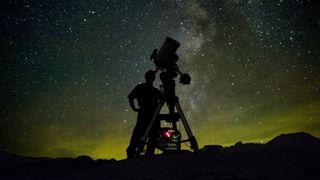September sees Venus blossom into a magnificent morning beacon, dazzlingly bright in the predawn eastern sky, a position it will maintain for the balance of the year.
Joining Venus later in the month, is the normally elusive planet Mercury, which will enjoy its best morning apparition of 2023. While this rocky little world usually lies very low to the horizon and is often difficult to pick out in a bright twilight sky, during the final week of the month it will be high enough and bright enough to readily pick out, sitting a good distance to the lower left of Venus.
Meanwhile, in the evening sky is Saturn, shining with a sedately yellow-white glow and will be visible for virtually the entire night, and brilliant Jupiter, making its presence felt in the eastern sky during the early-to-mid evening hours and is well up in the sky by midnight.
The only planet "out of the loop" is Mars, which will remain too near to the vicinity of the sun to be seen right through the end of the year.
Related: Night sky, September 2023: What you can see tonight [maps]
Read more: Best telescopes for seeing planets in 2023

Looking for a telescope to see the planets in August? We recommend the Celestron Astro Fi 102 as the top pick in our best beginner's telescope guide.
In our schedule, remember that when measuring the angular separation between two celestial objects, your clenched fist held at arm’s length measures roughly 10-degrees. Here, we present a schedule below which provides some of the best planet viewing times as well directing you as to where to look to see them.
Be sure to check out our best telescopes for viewing planets guide and our more general guides for the best binoculars and the best telescopes. If you're interested in taking your own impressive skywatching images, we have recommendations for the best cameras for astrophotography and the best lenses for astrophotography.
The sun

The sun crosses the equator on Sept. 23 at 2:50 a.m. Eastern daylight time, heading south. This equinox marks the beginning of fall in the Northern Hemisphere and spring in the Southern Hemisphere.
Mercury

Mercury moves through inferior conjunction on Sept. 6, then quickly enters the morning sky. By the 16th the planet is magnitude +1.0; look for it 23-degrees east (lower left) of Venus about 45 minutes before sunup. It kindles from magnitude +2.1 to +0.2 between Sept. 13 and 19, while the interval between Mercury-rise and sunrise increases from about 1 to 1.5 hours.
The planet reaches greatest elongation (18-degrees west of the sun) on the morning of Sept. 22, offering early risers at mid-northern latitudes its best dawn apparition of the year when it shines at magnitude -0.4. By Sept. 30, Mercury has nearly doubled in brightness to magnitude -1.0, but within a few days it becomes difficult to see in the morning twilight.
Venus

Venus climbs noticeably higher before dawn each week in September and burns brilliantly. Its altitude above the horizon 30 minutes before sunrise increases from 15-degrees to 34-degrees during September for viewers near latitude 40-degrees north. A slender (11% illuminated) waning crescent moon hovers far to the upper left of brilliant Venus in the predawn eastern sky of Sept. 11.
On Sept. 19, Venus flames to its greatest brightness of this morning apparition, magnitude -4.8. It is now so bright that you may be able to follow it with your naked eyes surprisingly easily all the way into daytime, given a crisp, deep-blue sky. It helps to use a marker for it, such as a treetop or the corner of a building. In a telescope you can watch Venus begin September as a thin, tall crescent, then wax to 36% illuminated by month's end – while shrinking into the distance all the while.
Mars

Mars is out of sight all the rest of this year, gradually passing behind the sun from our moving viewpoint on Earth.
Jupiter

Jupiter, the planetary behemoth, is a resplendent light in Aries, just above the head of Cetus the Whale. It doesn't rise until a few minutes past 10 p.m. on Sept. 1. But by month's end the brilliant planet comes up around the end of twilight, and it's high enough for good telescopic views by 11 p.m. or midnight. On Sept. 4, beginning around 10:30 p.m. daylight-saving time, look low toward the east-northeast and you will see the waning gibbous moon, and approximately 6 degrees to its right will be Jupiter.
During September, Jupiter brightens from magnitude -2.6 to -2.8, and its apparent diameter swells by 8%. Jupiter will reach a particularly close, bright opposition on Nov. 3.
Saturn

Saturn is the favorite planet to show the public through telescopes at star parties, and September finds it visible all night at its closest and biggest of the year. As night deepens, you'll see that this lovely world stands awesomely alone amidst the faint stars of Aquarius the Water Carrier. It's fairly high in the south in the south by midnight and its famous ring system widens somewhat from 9.2-degrees to 10-degrees during this month.
On Sept. 26, look low toward the southeast during evening twilight to see the rising waxing gibbous moon and situated about 4 degrees to its upper left you'll see Saturn mimicking a bright "star" (magnitude +0.5) shining with a yellowish glow.
Editor's Note: If you get a great photo of any of the planets and would like to share it with Space.com's readers, send your photo(s), comments, and your name and location to spacephotos@space.com.
Joe Rao serves as an instructor and guest lecturer at New York's Hayden Planetarium. He writes about astronomy for Natural History magazine, the Farmers' Almanac and other publications.


